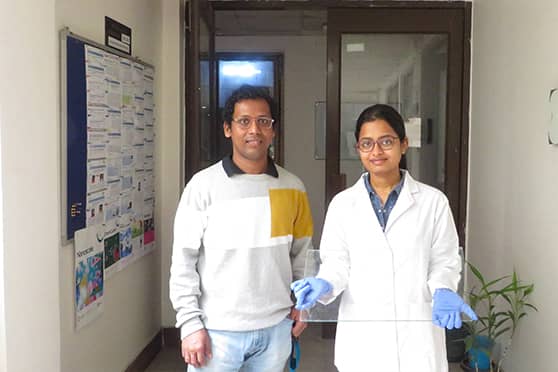IIT Guwahati researchers develop self-healable amphiphobic solid slippery coating


Researchers at Indian Institute of Technology (IIT) Guwahati have developed a self-healable amphiphobic solid slippery coating that shows self-healing of repetitive (50 times) physical damages in less than one minute, with the embedded slippery property remaining intact.
It also exhibits the sliding of droplets of various liquids — including water, polar and non-polar organic solvents, edible oil, motor, engine oil and crude oils.
The research team of IIT Guwahati is led by Uttam Manna, associate professor at the department of Chemistry and Centre for Nanotechnology, and includes research scholars Manideepa Dhar, Avijit Das and Dibyangana Parbat.
It is a simple and scalable fabrication of a non-fluorinated, substrate-independent and self-healable amphiphobic solid slippery coating. This coating exhibits sliding of droplets of various liquids including water, polar organic liquids (ethanol, 1-propanol, 1-hexanol, DMSO, DMF), and non-polar (decane, dodecane, diiodomethane) solvents, edible (vegetable oil), motor, engine (petrol, diesel, kerosene) and crude oils.
This surface can withstand prolonged exposures to various complex aqueous phases (pH 2, pH 12, SDS, and DTAB contaminated water, river water, seawater) and UV irradiation for 15 days. Substrate independence and scalable fabrication process are other crucial features of this current design.
This coating has been successfully developed on various substrates such as glass, aluminum foil, printed paper, plastic and so on, as well as geometrically complex objects like curved surfaces, inside of a glass bottle, etc. The simple fabrication process also allows coating on a large glass object (1,325 cm2).
Several researchers have attempted to build surfaces that are slippery to external fluids based on the slippery characteristics of the nepenthes pitcher plant. Joanna Aizenberg and her colleagues at Harvard University mimicked the technique of slipperiness used by the nepenthes pitcher plant and have developed an omniphobic slippery liquid-infused porous surface (SLIPS) through the strategic infusion of fluorinated liquid lubricant in an appropriately decorated porous and featured interface.
This defect-free, ultra-smooth, lubricant-infused slippery surface has a much-needed self-repairing ability, allowing it to endure severe physical abrasions. However, the leaching of infused fluorinated lubricant from the surface limits the ability of the surface to be used for more extended periods and contaminates the beaded liquids.
To eliminate this problem of infused fluorinated lubricant leaching, IIT Guwahati’s team of researchers have developed this simple and scalable fabrication of a non-fluorinated, substrate-independent and self-healable amphiphobic solid slippery coating. A hydrophilic porous polymeric coating has been strategically infused with a selected comb-like polymer to develop a crystalline network. Eventually, a self-healing and amphiphobic solid-slippery interface was obtained in the end.
The bottle that is decorated with such coating allowed traceless dispense of a viscous food item, i.e. honey with ease. Moreover, such coating protected the display of cell phones from any aqueous and oily contaminations. The prepared optically transparent solid slippery coating displayed a self-cleaning ability as well.